Effective Leadership Strategies for Multigenerational Teams: Report
VerifiedAdded on 2023/06/08
|9
|2048
|114
Report
AI Summary
This report delves into the complexities of leading multigenerational teams in the modern workplace, focusing on the distinct characteristics of traditionalists, baby boomers, Generation X, millennials, and Generation Z. It examines their values, perspectives, expectations, motivating factors, and behavioral traits, while also addressing the challenges of diversity and in-group/out-group dynamics. The report highlights the benefits of a multigenerational workforce and provides practical recommendations for leaders to effectively manage such diverse teams. Key areas of focus include tailored leadership approaches for each generation, addressing workplace conflicts, and creating a cohesive and productive environment. The report also explores how managers should lead each generation by taking into account their values and the factors which motivate each of them which makes the task quite complicated and time consuming. It concludes with best practices for leaders to implement for an effective multigenerational leadership.
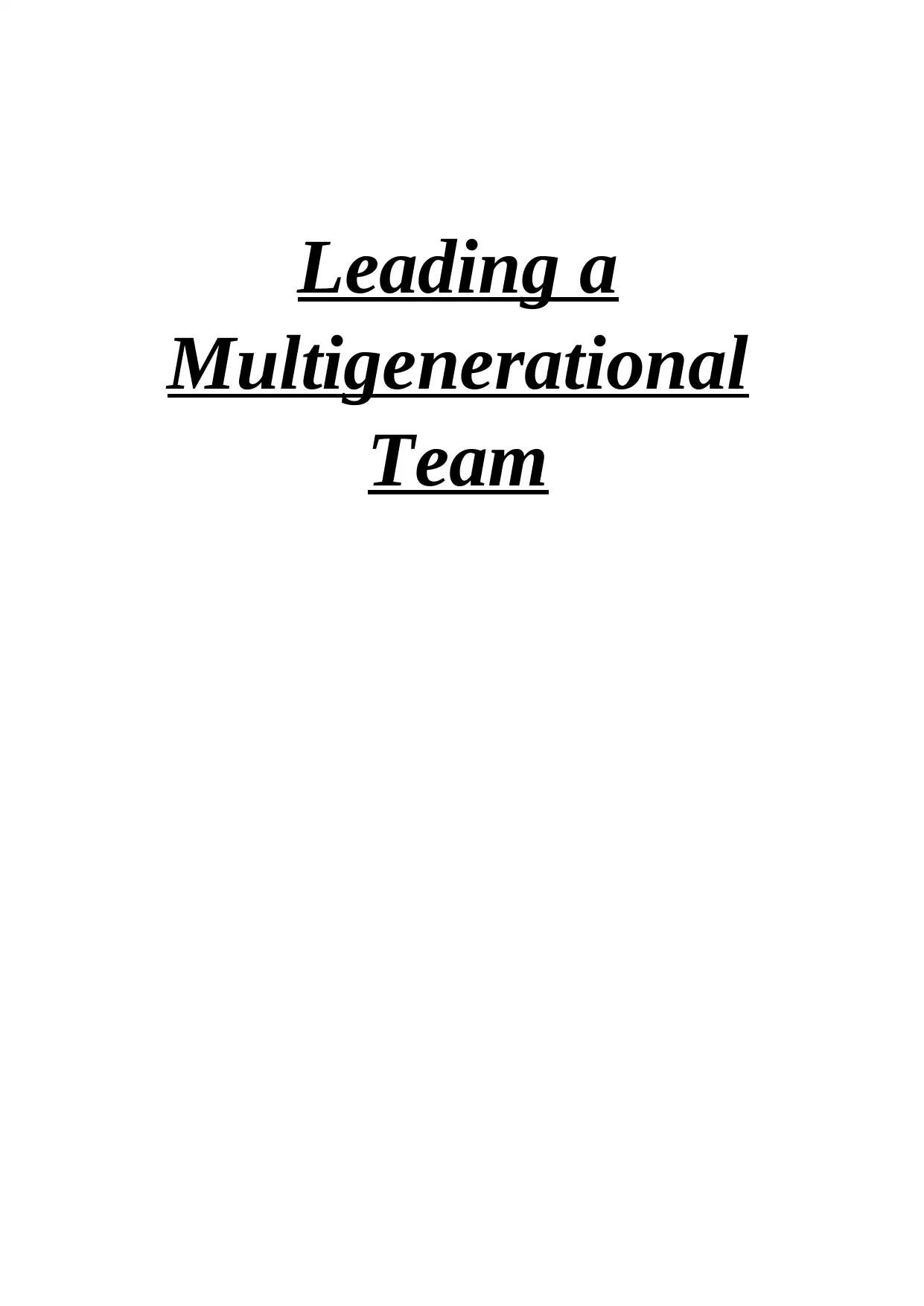
Leading a
Multigenerational
Team
Multigenerational
Team
Paraphrase This Document
Need a fresh take? Get an instant paraphrase of this document with our AI Paraphraser
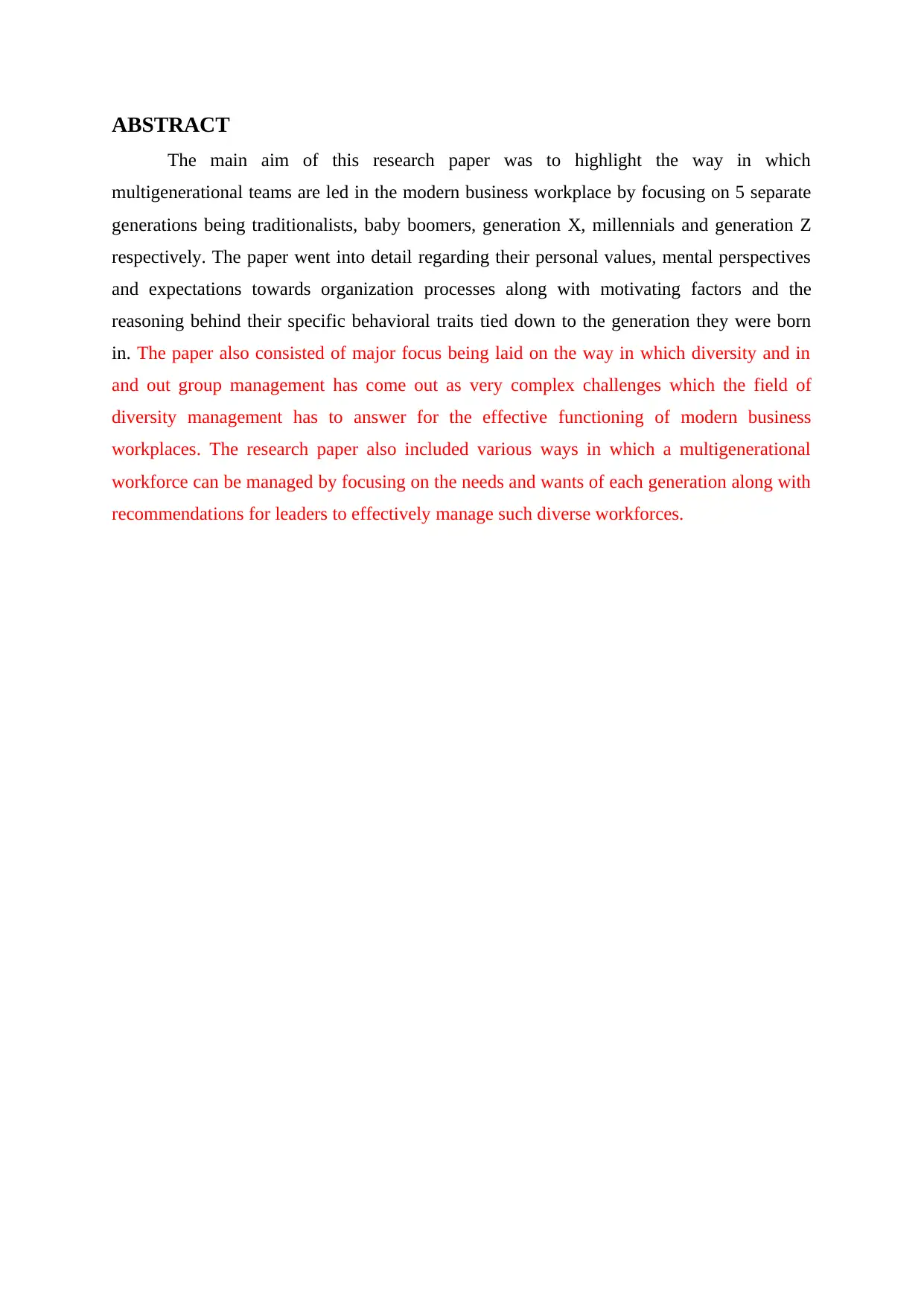
ABSTRACT
The main aim of this research paper was to highlight the way in which
multigenerational teams are led in the modern business workplace by focusing on 5 separate
generations being traditionalists, baby boomers, generation X, millennials and generation Z
respectively. The paper went into detail regarding their personal values, mental perspectives
and expectations towards organization processes along with motivating factors and the
reasoning behind their specific behavioral traits tied down to the generation they were born
in. The paper also consisted of major focus being laid on the way in which diversity and in
and out group management has come out as very complex challenges which the field of
diversity management has to answer for the effective functioning of modern business
workplaces. The research paper also included various ways in which a multigenerational
workforce can be managed by focusing on the needs and wants of each generation along with
recommendations for leaders to effectively manage such diverse workforces.
The main aim of this research paper was to highlight the way in which
multigenerational teams are led in the modern business workplace by focusing on 5 separate
generations being traditionalists, baby boomers, generation X, millennials and generation Z
respectively. The paper went into detail regarding their personal values, mental perspectives
and expectations towards organization processes along with motivating factors and the
reasoning behind their specific behavioral traits tied down to the generation they were born
in. The paper also consisted of major focus being laid on the way in which diversity and in
and out group management has come out as very complex challenges which the field of
diversity management has to answer for the effective functioning of modern business
workplaces. The research paper also included various ways in which a multigenerational
workforce can be managed by focusing on the needs and wants of each generation along with
recommendations for leaders to effectively manage such diverse workforces.
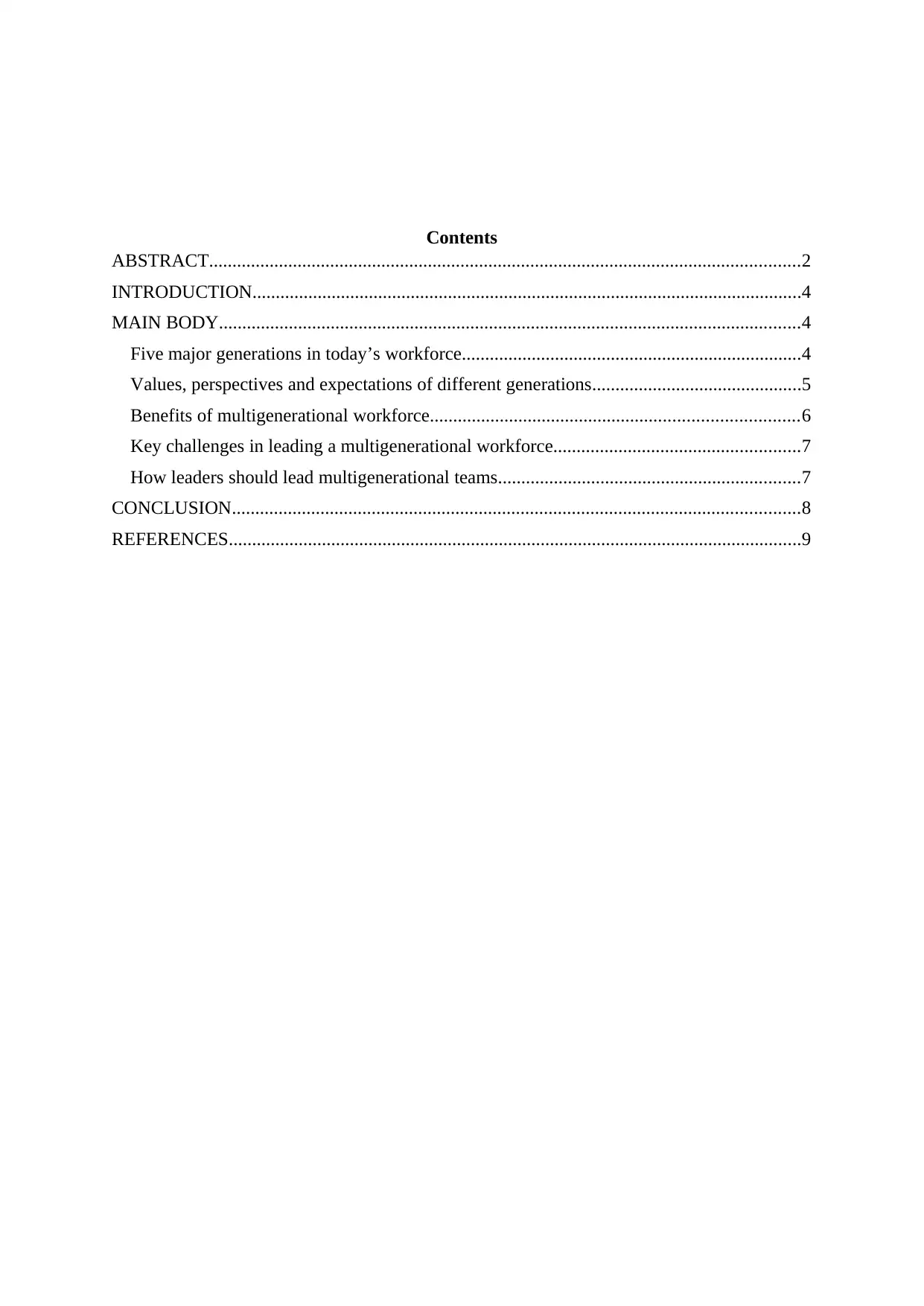
Contents
ABSTRACT...............................................................................................................................2
INTRODUCTION......................................................................................................................4
MAIN BODY.............................................................................................................................4
Five major generations in today’s workforce.........................................................................4
Values, perspectives and expectations of different generations.............................................5
Benefits of multigenerational workforce...............................................................................6
Key challenges in leading a multigenerational workforce.....................................................7
How leaders should lead multigenerational teams.................................................................7
CONCLUSION..........................................................................................................................8
REFERENCES...........................................................................................................................9
ABSTRACT...............................................................................................................................2
INTRODUCTION......................................................................................................................4
MAIN BODY.............................................................................................................................4
Five major generations in today’s workforce.........................................................................4
Values, perspectives and expectations of different generations.............................................5
Benefits of multigenerational workforce...............................................................................6
Key challenges in leading a multigenerational workforce.....................................................7
How leaders should lead multigenerational teams.................................................................7
CONCLUSION..........................................................................................................................8
REFERENCES...........................................................................................................................9
⊘ This is a preview!⊘
Do you want full access?
Subscribe today to unlock all pages.

Trusted by 1+ million students worldwide
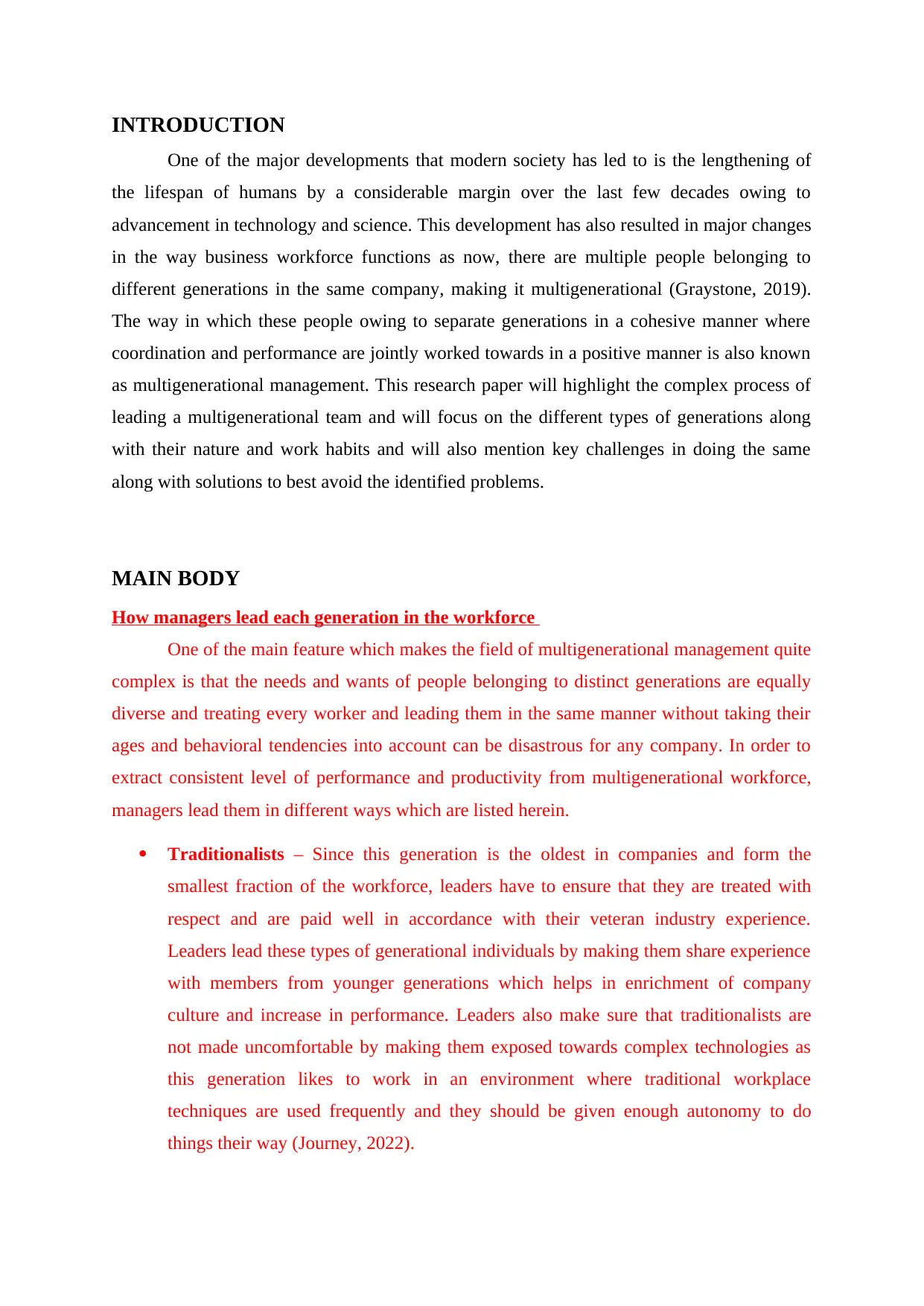
INTRODUCTION
One of the major developments that modern society has led to is the lengthening of
the lifespan of humans by a considerable margin over the last few decades owing to
advancement in technology and science. This development has also resulted in major changes
in the way business workforce functions as now, there are multiple people belonging to
different generations in the same company, making it multigenerational (Graystone, 2019).
The way in which these people owing to separate generations in a cohesive manner where
coordination and performance are jointly worked towards in a positive manner is also known
as multigenerational management. This research paper will highlight the complex process of
leading a multigenerational team and will focus on the different types of generations along
with their nature and work habits and will also mention key challenges in doing the same
along with solutions to best avoid the identified problems.
MAIN BODY
How managers lead each generation in the workforce
One of the main feature which makes the field of multigenerational management quite
complex is that the needs and wants of people belonging to distinct generations are equally
diverse and treating every worker and leading them in the same manner without taking their
ages and behavioral tendencies into account can be disastrous for any company. In order to
extract consistent level of performance and productivity from multigenerational workforce,
managers lead them in different ways which are listed herein.
Traditionalists – Since this generation is the oldest in companies and form the
smallest fraction of the workforce, leaders have to ensure that they are treated with
respect and are paid well in accordance with their veteran industry experience.
Leaders lead these types of generational individuals by making them share experience
with members from younger generations which helps in enrichment of company
culture and increase in performance. Leaders also make sure that traditionalists are
not made uncomfortable by making them exposed towards complex technologies as
this generation likes to work in an environment where traditional workplace
techniques are used frequently and they should be given enough autonomy to do
things their way (Journey, 2022).
One of the major developments that modern society has led to is the lengthening of
the lifespan of humans by a considerable margin over the last few decades owing to
advancement in technology and science. This development has also resulted in major changes
in the way business workforce functions as now, there are multiple people belonging to
different generations in the same company, making it multigenerational (Graystone, 2019).
The way in which these people owing to separate generations in a cohesive manner where
coordination and performance are jointly worked towards in a positive manner is also known
as multigenerational management. This research paper will highlight the complex process of
leading a multigenerational team and will focus on the different types of generations along
with their nature and work habits and will also mention key challenges in doing the same
along with solutions to best avoid the identified problems.
MAIN BODY
How managers lead each generation in the workforce
One of the main feature which makes the field of multigenerational management quite
complex is that the needs and wants of people belonging to distinct generations are equally
diverse and treating every worker and leading them in the same manner without taking their
ages and behavioral tendencies into account can be disastrous for any company. In order to
extract consistent level of performance and productivity from multigenerational workforce,
managers lead them in different ways which are listed herein.
Traditionalists – Since this generation is the oldest in companies and form the
smallest fraction of the workforce, leaders have to ensure that they are treated with
respect and are paid well in accordance with their veteran industry experience.
Leaders lead these types of generational individuals by making them share experience
with members from younger generations which helps in enrichment of company
culture and increase in performance. Leaders also make sure that traditionalists are
not made uncomfortable by making them exposed towards complex technologies as
this generation likes to work in an environment where traditional workplace
techniques are used frequently and they should be given enough autonomy to do
things their way (Journey, 2022).
Paraphrase This Document
Need a fresh take? Get an instant paraphrase of this document with our AI Paraphraser
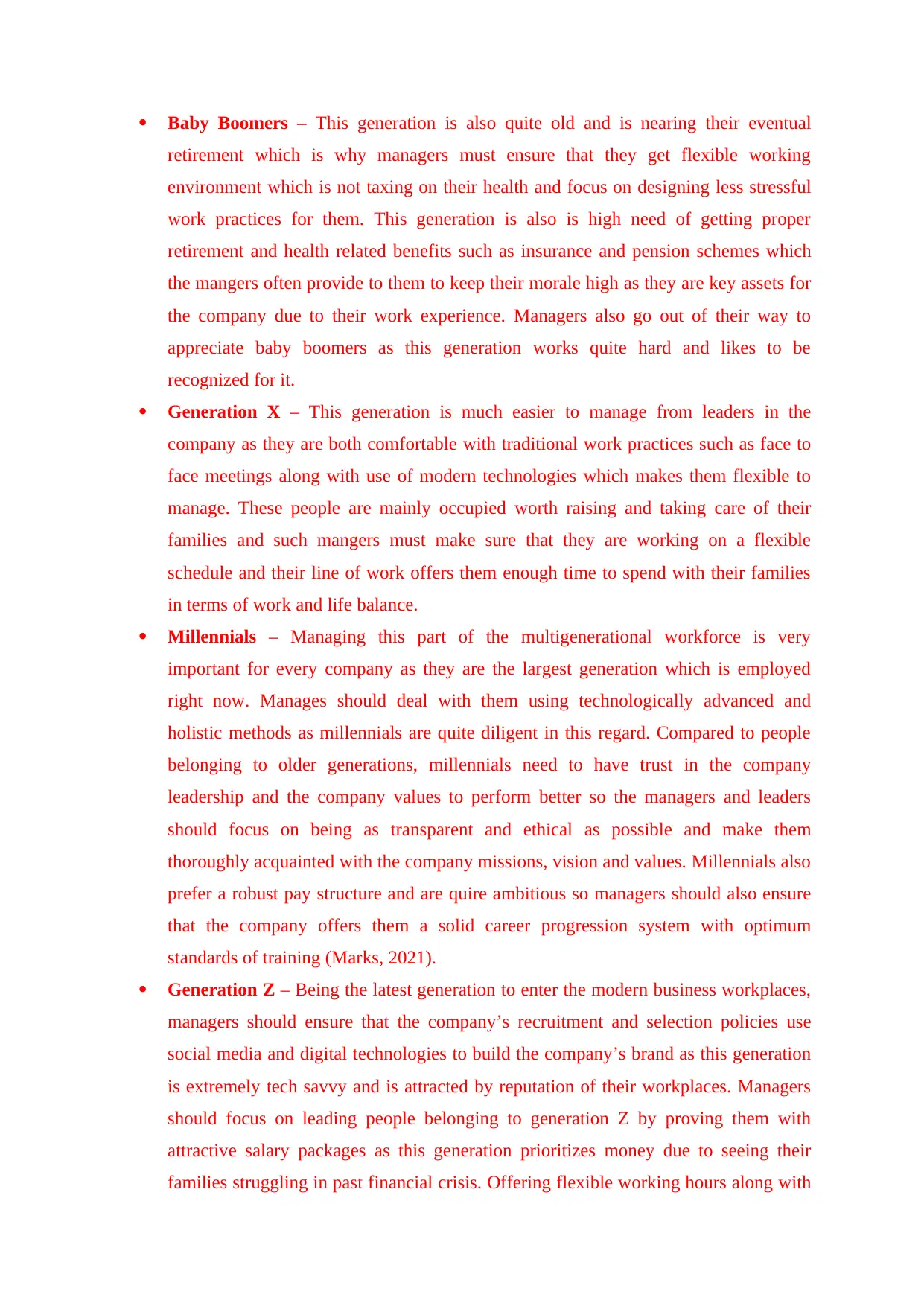
Baby Boomers – This generation is also quite old and is nearing their eventual
retirement which is why managers must ensure that they get flexible working
environment which is not taxing on their health and focus on designing less stressful
work practices for them. This generation is also is high need of getting proper
retirement and health related benefits such as insurance and pension schemes which
the mangers often provide to them to keep their morale high as they are key assets for
the company due to their work experience. Managers also go out of their way to
appreciate baby boomers as this generation works quite hard and likes to be
recognized for it.
Generation X – This generation is much easier to manage from leaders in the
company as they are both comfortable with traditional work practices such as face to
face meetings along with use of modern technologies which makes them flexible to
manage. These people are mainly occupied worth raising and taking care of their
families and such mangers must make sure that they are working on a flexible
schedule and their line of work offers them enough time to spend with their families
in terms of work and life balance.
Millennials – Managing this part of the multigenerational workforce is very
important for every company as they are the largest generation which is employed
right now. Manages should deal with them using technologically advanced and
holistic methods as millennials are quite diligent in this regard. Compared to people
belonging to older generations, millennials need to have trust in the company
leadership and the company values to perform better so the managers and leaders
should focus on being as transparent and ethical as possible and make them
thoroughly acquainted with the company missions, vision and values. Millennials also
prefer a robust pay structure and are quire ambitious so managers should also ensure
that the company offers them a solid career progression system with optimum
standards of training (Marks, 2021).
Generation Z – Being the latest generation to enter the modern business workplaces,
managers should ensure that the company’s recruitment and selection policies use
social media and digital technologies to build the company’s brand as this generation
is extremely tech savvy and is attracted by reputation of their workplaces. Managers
should focus on leading people belonging to generation Z by proving them with
attractive salary packages as this generation prioritizes money due to seeing their
families struggling in past financial crisis. Offering flexible working hours along with
retirement which is why managers must ensure that they get flexible working
environment which is not taxing on their health and focus on designing less stressful
work practices for them. This generation is also is high need of getting proper
retirement and health related benefits such as insurance and pension schemes which
the mangers often provide to them to keep their morale high as they are key assets for
the company due to their work experience. Managers also go out of their way to
appreciate baby boomers as this generation works quite hard and likes to be
recognized for it.
Generation X – This generation is much easier to manage from leaders in the
company as they are both comfortable with traditional work practices such as face to
face meetings along with use of modern technologies which makes them flexible to
manage. These people are mainly occupied worth raising and taking care of their
families and such mangers must make sure that they are working on a flexible
schedule and their line of work offers them enough time to spend with their families
in terms of work and life balance.
Millennials – Managing this part of the multigenerational workforce is very
important for every company as they are the largest generation which is employed
right now. Manages should deal with them using technologically advanced and
holistic methods as millennials are quite diligent in this regard. Compared to people
belonging to older generations, millennials need to have trust in the company
leadership and the company values to perform better so the managers and leaders
should focus on being as transparent and ethical as possible and make them
thoroughly acquainted with the company missions, vision and values. Millennials also
prefer a robust pay structure and are quire ambitious so managers should also ensure
that the company offers them a solid career progression system with optimum
standards of training (Marks, 2021).
Generation Z – Being the latest generation to enter the modern business workplaces,
managers should ensure that the company’s recruitment and selection policies use
social media and digital technologies to build the company’s brand as this generation
is extremely tech savvy and is attracted by reputation of their workplaces. Managers
should focus on leading people belonging to generation Z by proving them with
attractive salary packages as this generation prioritizes money due to seeing their
families struggling in past financial crisis. Offering flexible working hours along with
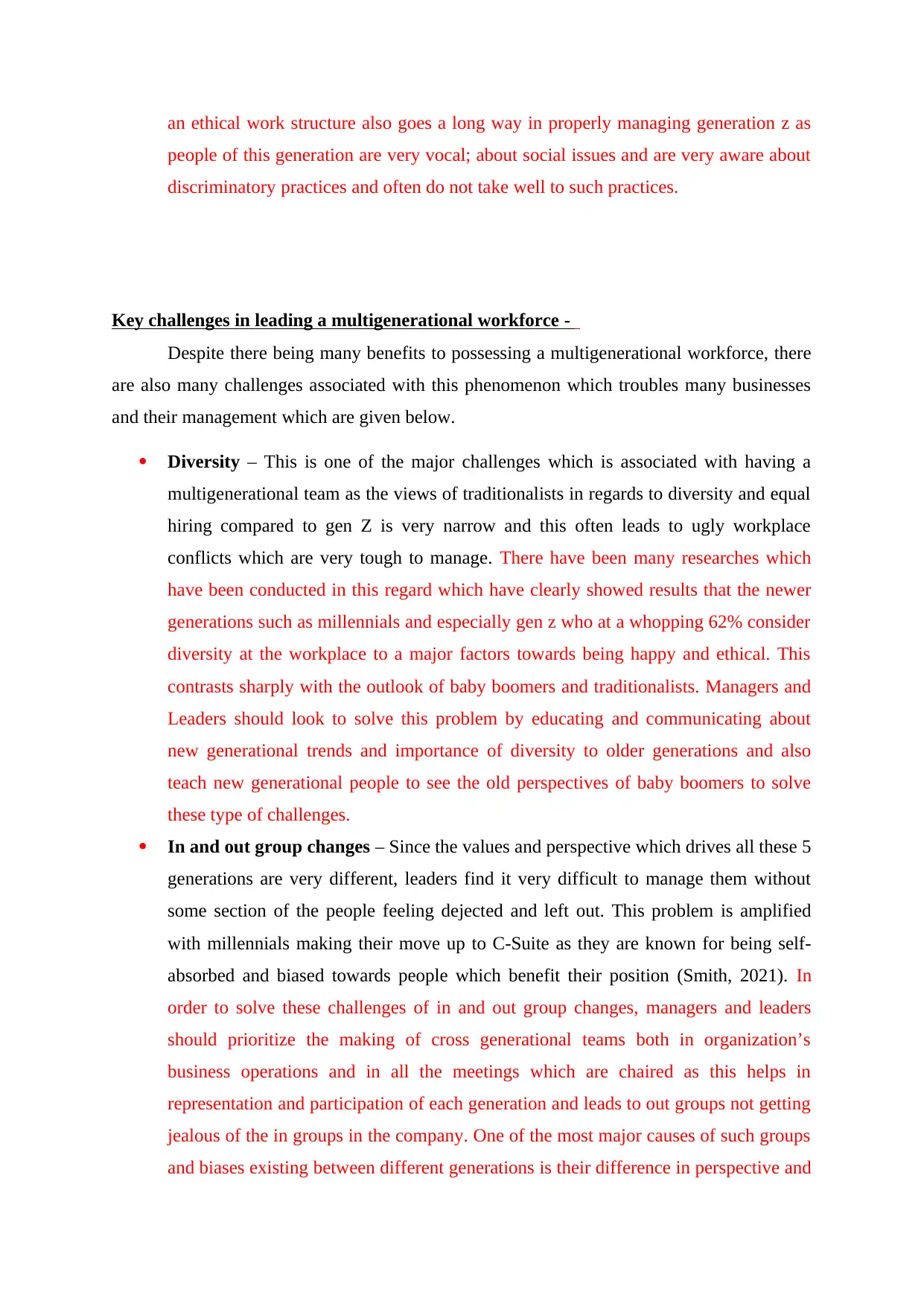
an ethical work structure also goes a long way in properly managing generation z as
people of this generation are very vocal; about social issues and are very aware about
discriminatory practices and often do not take well to such practices.
Key challenges in leading a multigenerational workforce -
Despite there being many benefits to possessing a multigenerational workforce, there
are also many challenges associated with this phenomenon which troubles many businesses
and their management which are given below.
Diversity – This is one of the major challenges which is associated with having a
multigenerational team as the views of traditionalists in regards to diversity and equal
hiring compared to gen Z is very narrow and this often leads to ugly workplace
conflicts which are very tough to manage. There have been many researches which
have been conducted in this regard which have clearly showed results that the newer
generations such as millennials and especially gen z who at a whopping 62% consider
diversity at the workplace to a major factors towards being happy and ethical. This
contrasts sharply with the outlook of baby boomers and traditionalists. Managers and
Leaders should look to solve this problem by educating and communicating about
new generational trends and importance of diversity to older generations and also
teach new generational people to see the old perspectives of baby boomers to solve
these type of challenges.
In and out group changes – Since the values and perspective which drives all these 5
generations are very different, leaders find it very difficult to manage them without
some section of the people feeling dejected and left out. This problem is amplified
with millennials making their move up to C-Suite as they are known for being self-
absorbed and biased towards people which benefit their position (Smith, 2021). In
order to solve these challenges of in and out group changes, managers and leaders
should prioritize the making of cross generational teams both in organization’s
business operations and in all the meetings which are chaired as this helps in
representation and participation of each generation and leads to out groups not getting
jealous of the in groups in the company. One of the most major causes of such groups
and biases existing between different generations is their difference in perspective and
people of this generation are very vocal; about social issues and are very aware about
discriminatory practices and often do not take well to such practices.
Key challenges in leading a multigenerational workforce -
Despite there being many benefits to possessing a multigenerational workforce, there
are also many challenges associated with this phenomenon which troubles many businesses
and their management which are given below.
Diversity – This is one of the major challenges which is associated with having a
multigenerational team as the views of traditionalists in regards to diversity and equal
hiring compared to gen Z is very narrow and this often leads to ugly workplace
conflicts which are very tough to manage. There have been many researches which
have been conducted in this regard which have clearly showed results that the newer
generations such as millennials and especially gen z who at a whopping 62% consider
diversity at the workplace to a major factors towards being happy and ethical. This
contrasts sharply with the outlook of baby boomers and traditionalists. Managers and
Leaders should look to solve this problem by educating and communicating about
new generational trends and importance of diversity to older generations and also
teach new generational people to see the old perspectives of baby boomers to solve
these type of challenges.
In and out group changes – Since the values and perspective which drives all these 5
generations are very different, leaders find it very difficult to manage them without
some section of the people feeling dejected and left out. This problem is amplified
with millennials making their move up to C-Suite as they are known for being self-
absorbed and biased towards people which benefit their position (Smith, 2021). In
order to solve these challenges of in and out group changes, managers and leaders
should prioritize the making of cross generational teams both in organization’s
business operations and in all the meetings which are chaired as this helps in
representation and participation of each generation and leads to out groups not getting
jealous of the in groups in the company. One of the most major causes of such groups
and biases existing between different generations is their difference in perspective and
⊘ This is a preview!⊘
Do you want full access?
Subscribe today to unlock all pages.

Trusted by 1+ million students worldwide
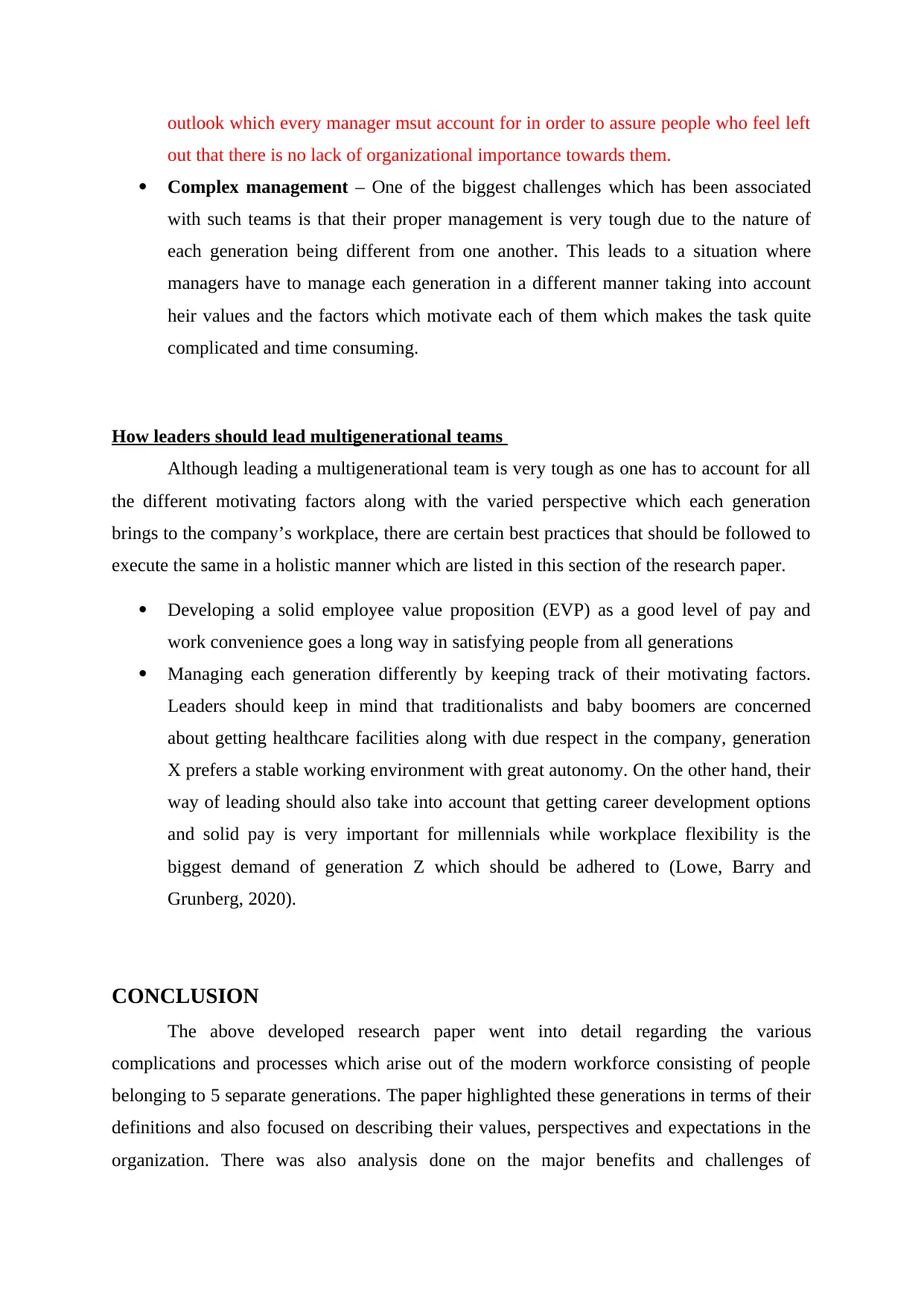
outlook which every manager msut account for in order to assure people who feel left
out that there is no lack of organizational importance towards them.
Complex management – One of the biggest challenges which has been associated
with such teams is that their proper management is very tough due to the nature of
each generation being different from one another. This leads to a situation where
managers have to manage each generation in a different manner taking into account
heir values and the factors which motivate each of them which makes the task quite
complicated and time consuming.
How leaders should lead multigenerational teams
Although leading a multigenerational team is very tough as one has to account for all
the different motivating factors along with the varied perspective which each generation
brings to the company’s workplace, there are certain best practices that should be followed to
execute the same in a holistic manner which are listed in this section of the research paper.
Developing a solid employee value proposition (EVP) as a good level of pay and
work convenience goes a long way in satisfying people from all generations
Managing each generation differently by keeping track of their motivating factors.
Leaders should keep in mind that traditionalists and baby boomers are concerned
about getting healthcare facilities along with due respect in the company, generation
X prefers a stable working environment with great autonomy. On the other hand, their
way of leading should also take into account that getting career development options
and solid pay is very important for millennials while workplace flexibility is the
biggest demand of generation Z which should be adhered to (Lowe, Barry and
Grunberg, 2020).
CONCLUSION
The above developed research paper went into detail regarding the various
complications and processes which arise out of the modern workforce consisting of people
belonging to 5 separate generations. The paper highlighted these generations in terms of their
definitions and also focused on describing their values, perspectives and expectations in the
organization. There was also analysis done on the major benefits and challenges of
out that there is no lack of organizational importance towards them.
Complex management – One of the biggest challenges which has been associated
with such teams is that their proper management is very tough due to the nature of
each generation being different from one another. This leads to a situation where
managers have to manage each generation in a different manner taking into account
heir values and the factors which motivate each of them which makes the task quite
complicated and time consuming.
How leaders should lead multigenerational teams
Although leading a multigenerational team is very tough as one has to account for all
the different motivating factors along with the varied perspective which each generation
brings to the company’s workplace, there are certain best practices that should be followed to
execute the same in a holistic manner which are listed in this section of the research paper.
Developing a solid employee value proposition (EVP) as a good level of pay and
work convenience goes a long way in satisfying people from all generations
Managing each generation differently by keeping track of their motivating factors.
Leaders should keep in mind that traditionalists and baby boomers are concerned
about getting healthcare facilities along with due respect in the company, generation
X prefers a stable working environment with great autonomy. On the other hand, their
way of leading should also take into account that getting career development options
and solid pay is very important for millennials while workplace flexibility is the
biggest demand of generation Z which should be adhered to (Lowe, Barry and
Grunberg, 2020).
CONCLUSION
The above developed research paper went into detail regarding the various
complications and processes which arise out of the modern workforce consisting of people
belonging to 5 separate generations. The paper highlighted these generations in terms of their
definitions and also focused on describing their values, perspectives and expectations in the
organization. There was also analysis done on the major benefits and challenges of
Paraphrase This Document
Need a fresh take? Get an instant paraphrase of this document with our AI Paraphraser
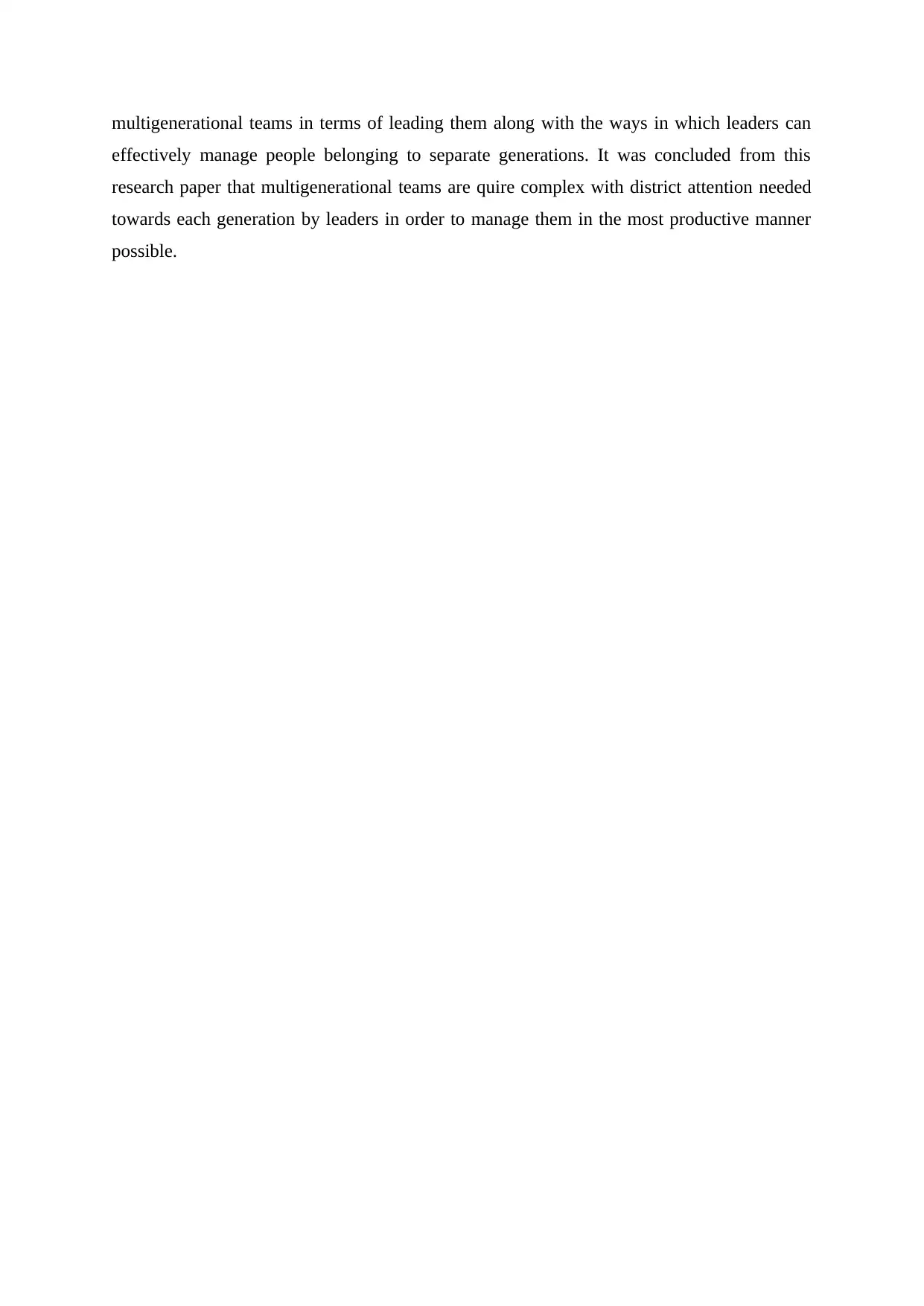
multigenerational teams in terms of leading them along with the ways in which leaders can
effectively manage people belonging to separate generations. It was concluded from this
research paper that multigenerational teams are quire complex with district attention needed
towards each generation by leaders in order to manage them in the most productive manner
possible.
effectively manage people belonging to separate generations. It was concluded from this
research paper that multigenerational teams are quire complex with district attention needed
towards each generation by leaders in order to manage them in the most productive manner
possible.
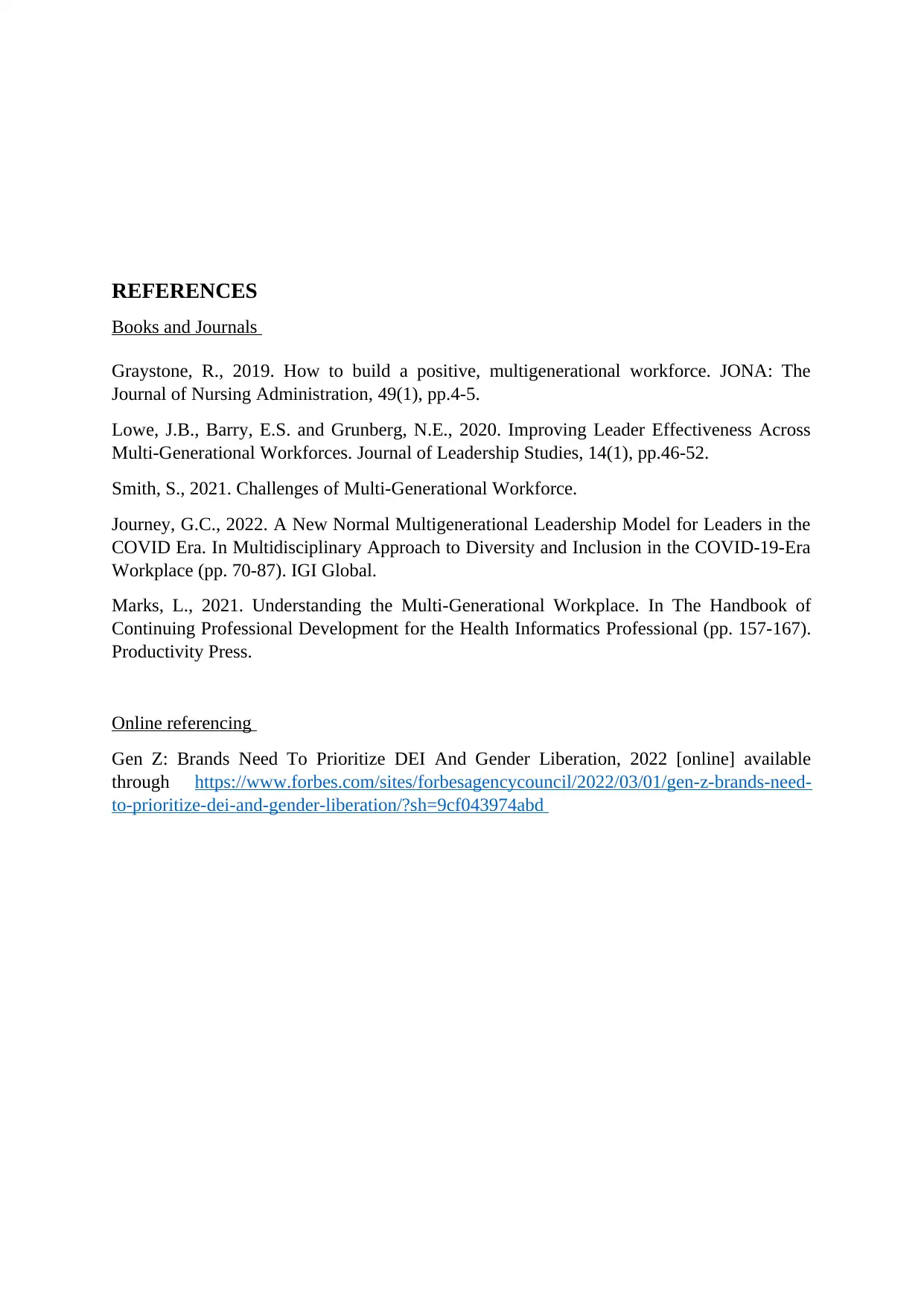
REFERENCES
Books and Journals
Graystone, R., 2019. How to build a positive, multigenerational workforce. JONA: The
Journal of Nursing Administration, 49(1), pp.4-5.
Lowe, J.B., Barry, E.S. and Grunberg, N.E., 2020. Improving Leader Effectiveness Across
Multi‐Generational Workforces. Journal of Leadership Studies, 14(1), pp.46-52.
Smith, S., 2021. Challenges of Multi-Generational Workforce.
Journey, G.C., 2022. A New Normal Multigenerational Leadership Model for Leaders in the
COVID Era. In Multidisciplinary Approach to Diversity and Inclusion in the COVID-19-Era
Workplace (pp. 70-87). IGI Global.
Marks, L., 2021. Understanding the Multi-Generational Workplace. In The Handbook of
Continuing Professional Development for the Health Informatics Professional (pp. 157-167).
Productivity Press.
Online referencing
Gen Z: Brands Need To Prioritize DEI And Gender Liberation, 2022 [online] available
through https://www.forbes.com/sites/forbesagencycouncil/2022/03/01/gen-z-brands-need-
to-prioritize-dei-and-gender-liberation/?sh=9cf043974abd
Books and Journals
Graystone, R., 2019. How to build a positive, multigenerational workforce. JONA: The
Journal of Nursing Administration, 49(1), pp.4-5.
Lowe, J.B., Barry, E.S. and Grunberg, N.E., 2020. Improving Leader Effectiveness Across
Multi‐Generational Workforces. Journal of Leadership Studies, 14(1), pp.46-52.
Smith, S., 2021. Challenges of Multi-Generational Workforce.
Journey, G.C., 2022. A New Normal Multigenerational Leadership Model for Leaders in the
COVID Era. In Multidisciplinary Approach to Diversity and Inclusion in the COVID-19-Era
Workplace (pp. 70-87). IGI Global.
Marks, L., 2021. Understanding the Multi-Generational Workplace. In The Handbook of
Continuing Professional Development for the Health Informatics Professional (pp. 157-167).
Productivity Press.
Online referencing
Gen Z: Brands Need To Prioritize DEI And Gender Liberation, 2022 [online] available
through https://www.forbes.com/sites/forbesagencycouncil/2022/03/01/gen-z-brands-need-
to-prioritize-dei-and-gender-liberation/?sh=9cf043974abd
⊘ This is a preview!⊘
Do you want full access?
Subscribe today to unlock all pages.

Trusted by 1+ million students worldwide
1 out of 9
Related Documents
Your All-in-One AI-Powered Toolkit for Academic Success.
+13062052269
info@desklib.com
Available 24*7 on WhatsApp / Email
![[object Object]](/_next/static/media/star-bottom.7253800d.svg)
Unlock your academic potential
Copyright © 2020–2025 A2Z Services. All Rights Reserved. Developed and managed by ZUCOL.





